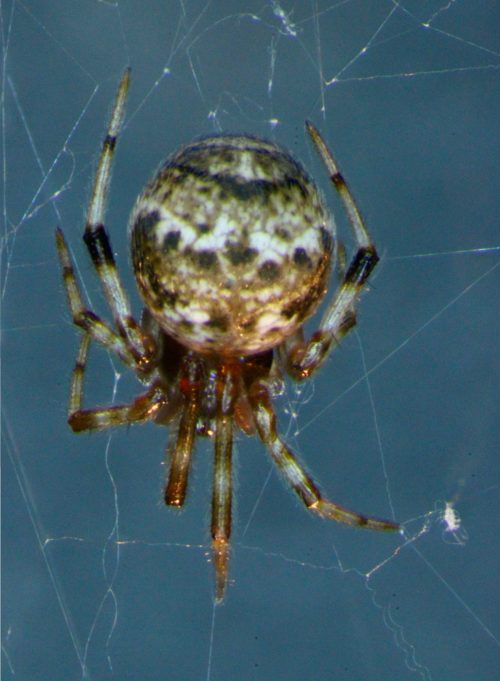Today’s hour of spider-zen was spent feeding (they were hungry — they always hunger) and tinkering with the photography lighting. The image below is a product of some experimenting: I use an LED ring light attached to the microscope, which gives a uniform brightness to everything, which isn’t always desirable. My photographs come out looking flat, with shadows mostly lost. So today I 1) used a darkfield background, and 2) fired up my halogen lamp with the fiber-optic dual goosenecks, and tried lighting more from the side. I still have some work to do, but I kind of like this image. The side-lighting and darker background is much more effective at imaging the spider silk, and the warmer lighting of the halogen added some lovely red-gold highlights to the spider.
Compared to my other recent photo, I think it’s less cartoony and much more true to life.
The photomicrography experiments must continue.
Except now I’ve got a class coming up. I wonder what I’m going to say?



It is obvious what you should be doing! Offer a nature microphotography class as an elective. Include the study of external anatomy to get the BIO prefix.
Nice photo!
I have a pet peeve about ring lights unrelated to science, and that’s in videos and photos where the subject ends up with little white rings reflected in their eyes. I find it unnatural and weird, and it bugs the hell out of me.
The other thing is color. For a lot of applications it’s not critical, but given that perception of color is relative to both it’s surroundings and light temperature, there’s a part of me (or maybe it’s just an irrational compulsion) that wants to clamp down on color hygiene where identification is more of an issue than art.
Anyway, I think you’re right, directional light renders the subject better. A rule of thumb is to have the main light source come from the upper left. Obviously not appropriate in this case, but it’s generally more comfortable for viewers, and can be critical in interpreting relief. Maybe the best example of that is in some satellite photos where it determines whether you’re looking at a bump or a depression.
Also light from below is spooky.
That is a good photo. Are you familiar with Alex Wild’s site Myrmecos? His main focus are ants but he has a lot of other insects as well. CNN has a story about turning spider webs into music.
https://www.cnn.com/videos/business/2021/04/14/mit-spiderweb-music-scn.cnn/video/playlists/business-news/
Yes. I am jealous of Alex, so of course I know of him.
nicknamenone, #3:
Sort of interesting, I guess. But other than creating headlines and getting people like us to talk about it, I’m not sure what is supposed to be the point of that kind of data sonification.
I look at a spider web, and I can just see what’s going on — the whole thing. It’s certainly a complicated structure to try to take in all at once, but at least one nice thing is that it doesn’t require a terribly sophisticated interpretation of my visual experience itself, simply to have a reasonably good idea of what I’m looking at. You shouldn’t be too naive about this sort of thing, of course, but at least when just looking at some images of webs (not necessarily other kinds of images) you don’t exactly need to be equipped with much beyond some basic common sense I guess.
Meanwhile, even though I’ve been a musician for a long time, which includes doing the same sort of sound design and so forth that must have gone into this, I don’t know what to do with the sounds they generated based on the spider web data. I think I sort of get what they’re trying to do, but I still just feel lost, frankly. (By the way, instead of the CNN one, here’s a somewhat more informative video. Still not terribly helpful.)
And if, as they’re saying, they also want to use machine learning or whatever to try to analyze the webs, make artificial ones, communicate with spiders, or who knows what … well, the computer doesn’t need it in audio form either. It only needs to work with the data.
So, I don’t know. To me, it just seems like a very fancy type of press release (maybe hoping they’ll get some more funding to pump out even more press releases), rather than the usual printed words, which I guess are too boring and unmysterious for some people.
Consciousness Razor,
I pretty much agree with you. I don’t see the point of making the webs into music except as an exercise to do it. I am not sure how it helps map the webs and I don’t see how it helps communicate with the spiders. Yes spiders react to vibrations and music is vibrations but….
I just thought it would be interesting to a PZ Myers since he is working with spiders now.
It does sound a bit like a modern composition so I suppose it works as a piece of art.
https://arstechnica.com/science/2021/04/mit-scientists-study-spider-web-structure-by-translating-it-into-music/
“MIT scientists study spider web structure by translating it into music
“A spider weaving its intricate web is a bit like a person composing a song, at least in the eyes of MIT materials engineer Markus Buehler, whose research involves translating web structure into musical melodies. Together with his collaborators, he has devised a way for humans to “enter” a 3D spider web and explore its structure both visually and aurally via a virtual reality setup. Buehler described the ongoing project during a talk at the (virtual) meeting of the American Chemical Society (ACS) this week.”
I dunno, seems like the 3D mapping could be useful.
Do the webs of different spiders make different sounds?